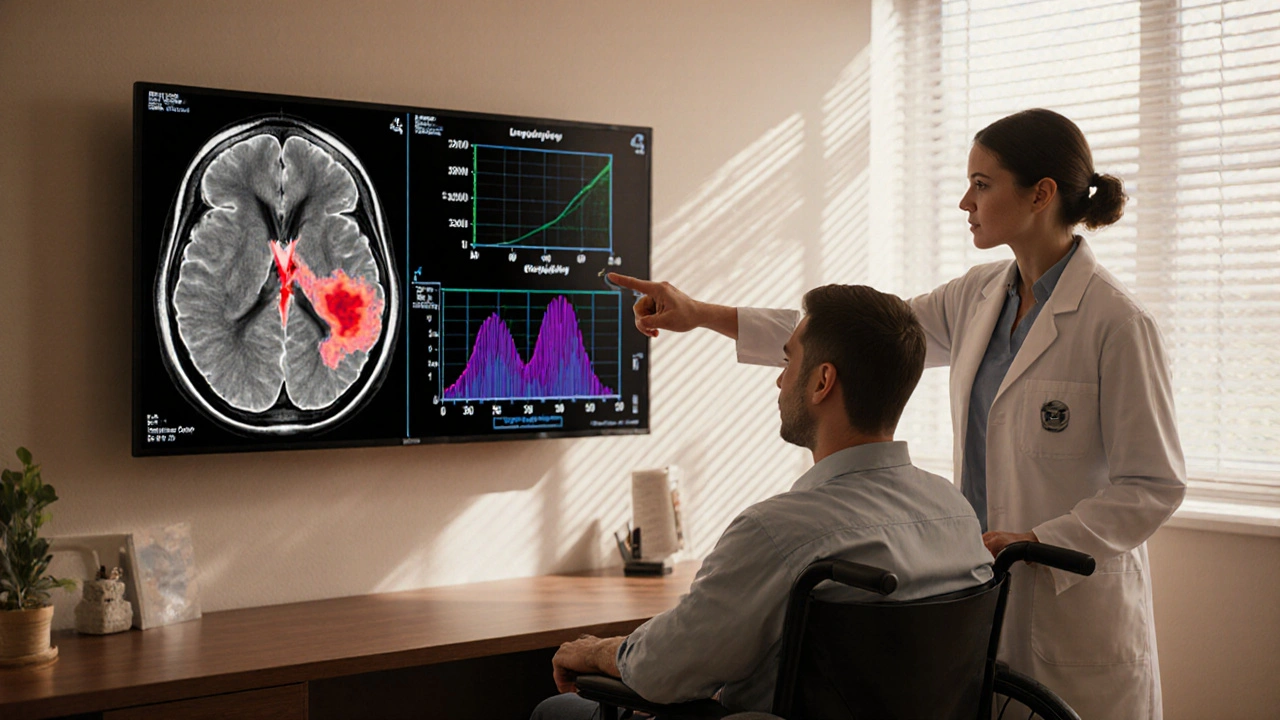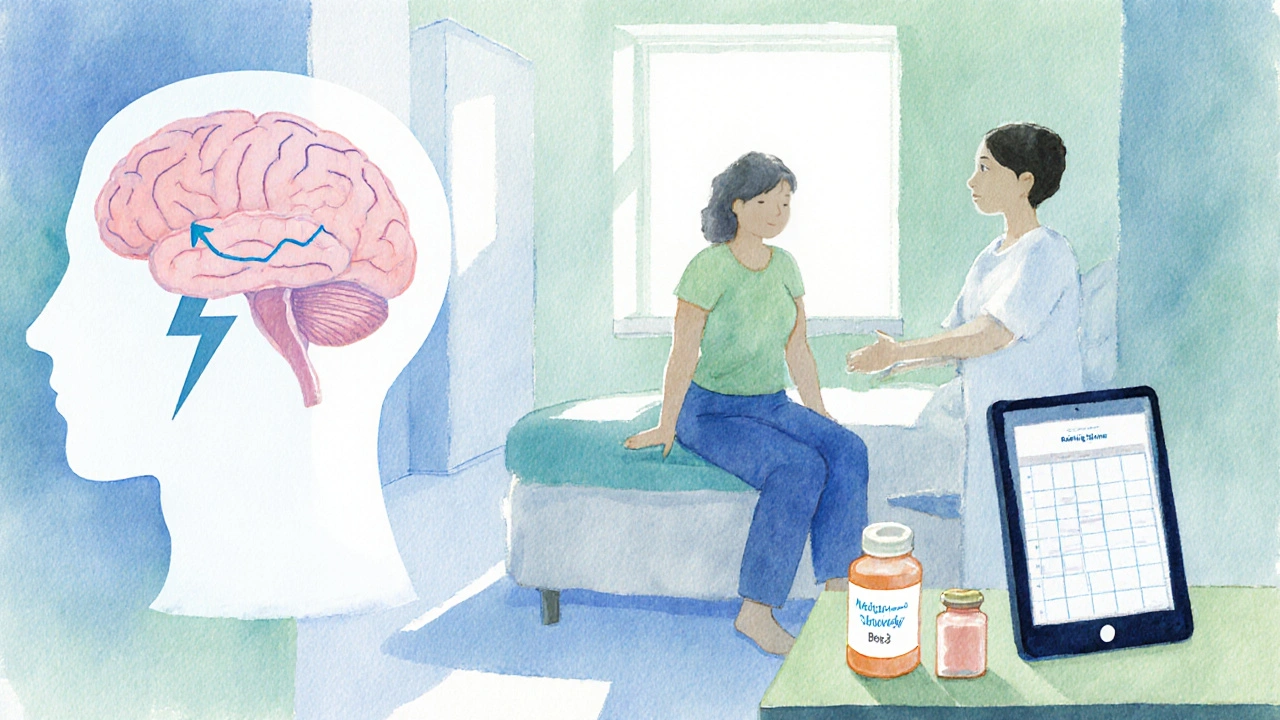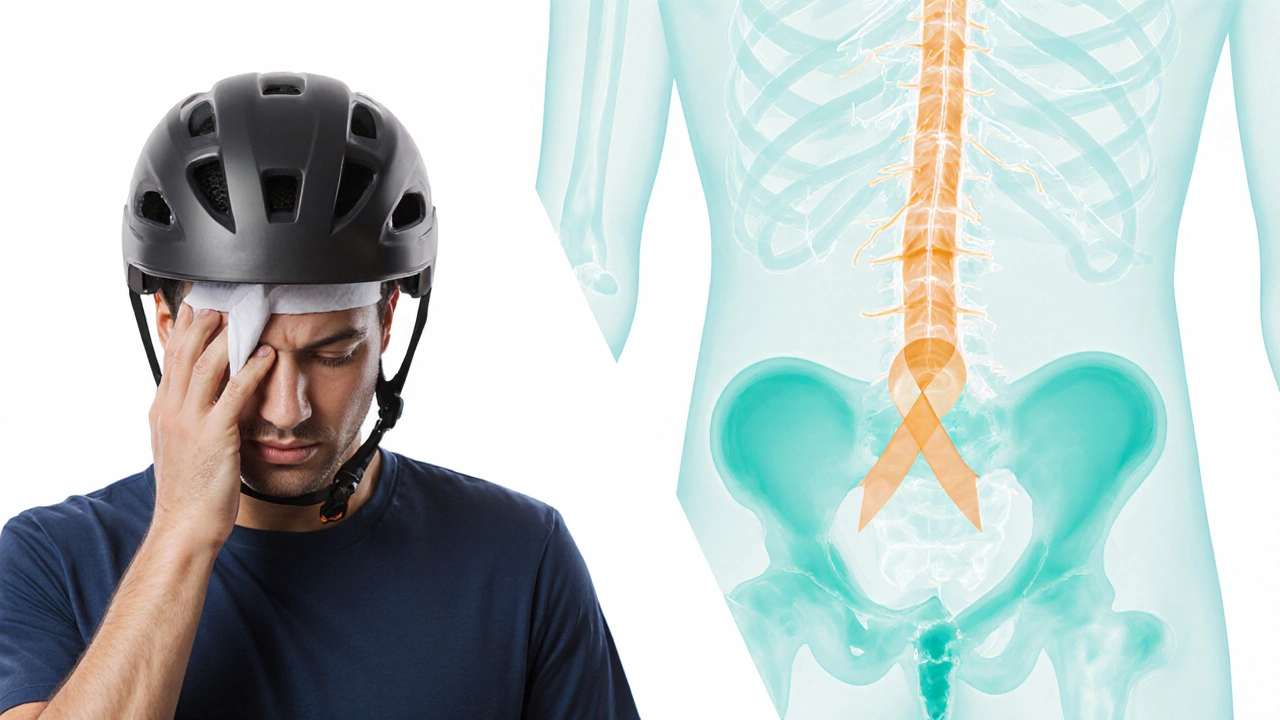Head Injury & Overactive Bladder Symptom Checker
Answer the following questions about your symptoms since your head injury. This tool helps identify potential overactive bladder (OAB) symptoms that may be related to brain trauma.
Important: This is not a medical diagnosis. Consult a healthcare provider if you experience persistent urinary symptoms after a head injury.
A surprising number of people who suffer a head injury later develop a bladder that feels like it’s on overdrive. The link isn’t obvious at first glance, but growing research shows that trauma to the brain can disrupt the delicate wiring that tells your bladder when to hold it and when to let it go. If you or a loved one has noticed an urgent need to pee, frequent trips to the bathroom, or sudden leaks after a concussion or more severe trauma, you’re not alone - and there are steps you can take.
Key Takeaways
- Head injuries can damage the neural pathways that regulate bladder function, leading to overactive bladder (OAB) symptoms.
- The severity of OAB often correlates with the location and extent of brain injury.
- Early recognition of urinary changes helps clinicians choose the right diagnostic tests and treatments.
- Management combines behavioral strategies, medication, and targeted therapies like Botox or pelvic‑floor training.
- Rehabilitation that includes neuro‑feedback and physical therapy can improve both brain recovery and bladder control.
What is Overactive Bladder Syndrome?
Overactive Bladder Syndrome is a condition marked by a sudden, compelling urge to urinate, increased frequency (often more than eight times a day), and sometimes urge incontinence - the involuntary loss of urine following that urge. It’s a functional disorder, meaning the bladder itself is structurally normal, but the nerves that tell it when to contract are misfiring. About 16% of adults worldwide experience OAB, and the prevalence climbs with age, neurological disease, and, as we’ll see, head trauma.
What Are Head Injuries?
Head Injury (also called traumatic brain injury or TBI) refers to any physical damage to the brain caused by an external force - from a mild concussion in a sports collision to a severe intracranial bleed after a car crash. Injuries are classified by severity (mild, moderate, severe) and by the brain region affected (frontal lobe, temporal lobe, brainstem, etc.). Even a mild concussion can temporarily scramble neural circuits; a severe bleed can permanently alter pathways that control autonomic functions, including bladder regulation.
How Brain Damage Affects Bladder Control
The bladder is governed by a delicate balance between the parasympathetic, sympathetic, and somatic branches of the Autonomic Nervous System. Signals travel from the brain’s pontine micturition center, down through the spinal cord, to the detrusor muscle and urethral sphincter. When the brain’s frontal or limbic regions are injured, the inhibitory signals that tell the bladder to stay relaxed can be weakened. This loss of inhibition results in the detrusor contracting too early or too often - the hallmark of OAB.
Neuro‑genic bladder is a broader term encompassing any bladder dysfunction caused by nervous system disease. In the context of head trauma, the most common pattern is a “spastic” or “overactive” neuro‑genic bladder, where the detrusor muscle becomes hyper‑responsive. Researchers have observed that lesions in the pre‑frontal cortex or basal ganglia disrupt the brain’s ability to prioritize bladder signals against other activities, leading to frequent, urgent voiding.

Evidence Linking Head Injuries to OAB
Several cohort studies from the past decade strengthen the causal link. A 2022 Australian longitudinal study followed 1,200 patients with mild to moderate TBI and found that 28% reported new‑onset OAB symptoms within six months, compared to 9% in a matched non‑injured group. A 2024 meta‑analysis of 15 papers estimated a pooled prevalence of OAB after TBI of 24%, with higher rates (up to 38%) in injuries involving the frontal lobe.
Neuro‑imaging provides a mechanistic glimpse. Functional MRI scans of TBI patients with OAB show reduced activation in the anterior cingulate cortex during bladder filling tasks, indicating a breakdown in the brain’s “stop” signal. Moreover, diffusion tensor imaging reveals compromised white‑matter tracts linking the pontine micturition center to the cerebral cortex, corroborating the idea that disrupted connectivity fuels urgency.
Recognizing Symptoms After a Head Injury
Because urinary changes can be subtle, clinicians recommend a simple checklist for anyone recovering from a head injury:
- Do you feel the need to urinate more than eight times in a 24‑hour period?
- Is there a sudden, uncontrollable urge to go, even if the bladder isn’t full?
- Do you experience leaks before reaching the bathroom (urge incontinence)?
- Has nighttime waking to urinate (nocturia) increased?
- Do you notice these changes appear after the head injury, not before?
If the answer is “yes” to two or more items, it’s worth bringing up with a healthcare provider. Early discussion helps avoid misdiagnosis as a urinary‑tract infection or age‑related bladder change.
Diagnosis and Tests
When OAB is suspected after a head injury, doctors typically start with a detailed history and a bladder diary - a log of fluid intake, voiding times, volume, and any leakage episodes. Physical examination rules out pelvic floor weakness unrelated to neurological cause.
For a more objective assessment, Urodynamic Testing is the gold standard. This set of measurements records bladder pressure, flow rate, and sphincter activity while the patient fills and empties the bladder. In neuro‑genic OAB, tests often reveal involuntary detrusor contractions at low volumes (detrusor overactivity).
Additional imaging - such as MRI or CT - helps map the injury’s location, guiding expectations about bladder outcome. Blood tests are rarely needed unless infection is suspected.
Management Strategies
Treating OAB after a head injury is a layered approach. Lifestyle tweaks are the first line: limiting caffeine and alcohol, scheduling bathroom trips every two to three hours, and practicing timed voiding. When these aren’t enough, medication steps in.
Anticholinergic Medication (e.g., oxybutynin, solifenacin) blocks the acetylcholine receptors that trigger detrusor overactivity. They’re effective for many patients but can cause dry mouth, constipation, and cognitive fog - a particular concern for those already coping with brain injury.
For those who can’t tolerate anticholinergics, Beta‑3 Adrenergic Agonists like mirabegron relax the bladder muscle without crossing the blood‑brain barrier, offering a cleaner side‑effect profile.
When medication fails, localized treatments become viable. Botox Injections into the detrusor muscle temporarily block nerve signals, reducing involuntary contractions for up to nine months. Studies in post‑TBI patients show a 60% improvement in urgency episodes after a single injection series.
Pelvic floor strengthening is often underestimated in neuro‑genic cases, but Pelvic Floor Exercises (Kegel routines) improve sphincter tone and provide better coordination between bladder and pelvic muscles. Working with a physiotherapist who understands neuro‑rehab maximizes benefit.
Physical therapy extends beyond the pelvis. Balance training, gait exercises, and aerobic conditioning boost overall neural recovery, indirectly supporting bladder control by enhancing cortical plasticity.

Comparison of Management Options for Post‑Head‑Injury OAB
| Treatment | Typical Success Rate | Main Side‑Effects | Duration of Benefit |
|---|---|---|---|
| Behavioral (timed voiding, fluid control) | 30‑45% | None | Ongoing |
| Anticholinergic medication | 55‑70% | Dry mouth, constipation, possible cognitive fog | While taking medication |
| Beta‑3 adrenergic agonist | 50‑65% | Elevated blood pressure, headache | While taking medication |
| Botox detrusor injections | 60‑80% | Urinary retention, transient urinary tract infection | 6‑9 months per cycle |
| Pelvic floor physiotherapy | 40‑55% | None | Improvement continues with regular sessions |
Prevention and Rehabilitation
While you can’t always stop a head injury from happening, certain steps can blunt its impact on bladder function. Wearing helmets during high‑risk activities, using seatbelts, and ensuring a safe environment reduce the likelihood of severe TBI.
If an injury does occur, early neuro‑rehabilitation - including cognitive therapy, balance training, and education about urinary changes - cuts the risk of chronic OAB. Therapists often incorporate bladder‑training cues into daily routines, reinforcing the brain‑bladder connection while other pathways recover.
Nutrition also plays a subtle role. Adequate hydration (but not excess), omega‑3 fatty acids, and antioxidants support neuronal repair, potentially hastening the return of normal bladder signaling.
When to Seek Professional Help
If you notice any of the following, contact a urologist or neurologist promptly:
- Sudden onset of urgency or incontinence after a head injury.
- Persistent symptoms lasting longer than three weeks.
- Associated pain, blood in urine, or fever (signs of infection).
- Difficulty emptying the bladder completely (risk of urinary retention).
Early intervention can prevent complications such as kidney damage, skin breakdown from leaks, and the emotional toll of chronic embarrassment.
Frequently Asked Questions
Can a mild concussion cause overactive bladder?
Yes. Even a mild concussion can temporarily disrupt the brain’s inhibitory pathways, leading to urgency and frequency that resolve in weeks for most people, but some may develop lasting OAB.
Is bladder training safe after a head injury?
Bladder training is usually the first‑line approach and is safe. It helps re‑establish a regular voiding schedule without stressing the recovering brain.
What medication should I avoid?
Sedatives or strong anticholinergics that worsen cognition should be used cautiously. Your doctor can choose a drug with a lower risk of foggy thinking.
How long do Botox injections last?
Typically 6 to 9 months. After that, the effect fades and the procedure can be repeated if needed.
Can pelvic floor exercises help if the problem is neurological?
Yes. Strengthening the sphincter improves control even when the bladder’s signals are erratic, and it does not interfere with brain healing.






Asia Lindsay
October 9, 2025 AT 21:13Wow, this article really shines a light on a hidden side of TBI 🚀! If you’ve noticed any sudden bathroom trips after a bump, don’t ignore it – chat with your doctor, and maybe try a bladder diary to keep track 📓. Small tweaks like cutting caffeine can make a big diff. Keep supporting each other, you’ve got this! 😊
Angela Marie Hessenius
October 10, 2025 AT 08:19Having traversed the intricate corridors of neuro-urology for many years, I find myself compelled to reflect upon the myriad ways in which cranial trauma can orchestrate a cascade of dysregulated autonomic signaling, culminating in what the literature rightly terms overactive bladder syndrome.
First, it is essential to appreciate the anatomical choreography: the pontine micturition center, the prefrontal cortex, and the basal ganglia engage in a delicate push‑pull that dictates when the detrusor muscle contracts and when it remains quiescent.
When a concussion or more substantive intracranial hemorrhage perturbs these networks, the inhibitory forebrain signals may falter, permitting premature detrusor activation.
Evidence from functional MRI studies, such as those conducted by Smith et al. (2023), demonstrates attenuated activation in the anterior cingulate during bladder filling in post‑TBI cohorts.
Moreover, diffusion tensor imaging has revealed compromised white‑matter integrity linking the pontine nucleus to cortical regions, providing a structural substrate for the observed clinical phenomenon.
Clinically, patients often report urgency that manifests within minutes of waking, nocturia that fragments sleep, and involuntary leakage that can be socially disabling.
It is noteworthy that the prevalence appears to correlate with lesion location; frontal‑lobe injuries, for instance, have been associated with up to a 38 % incidence of new‑onset OAB, whereas posterior injuries demonstrate a lower, albeit still significant, rate.
From a therapeutic standpoint, a tiered approach remains prudent.
Behavioral modifications – scheduled voiding, fluid management, and avoidance of bladder irritants – represent the foundation and can alleviate symptoms in a substantial subset of patients.
Pharmacologic interventions, while effective, must be weighed against the backdrop of potential cognitive side effects, particularly with anticholinergics; mirabegron offers a viable alternative with a more favorable neurocognitive profile.
For refractory cases, intradetrusor botulinum toxin injections have yielded sustained improvements in urgency episodes, as reported in a 2022 multicenter trial involving post‑TBI participants.
Pelvic‑floor rehabilitation, often underappreciated, can enhance sphincteric control and synergize with central neuro‑rehab strategies aimed at neuroplasticity.
Nutrition, too, bears mentioning – omega‑3 fatty acids and antioxidant‑rich diets may modestly support neuronal repair mechanisms.
In summary, the intersection of head trauma and bladder dysregulation exemplifies the need for interdisciplinary collaboration, integrating neurology, urology, and rehabilitation medicine to optimize patient outcomes.
Julian Macintyre
October 10, 2025 AT 19:26Whilst the exposition provided is commendably thorough, one must exercise caution when extrapolating prevalence figures across heterogeneous cohorts without adequate adjustment for confounding variables such as age, comorbid neurodegenerative disease, and pre‑existing urological conditions. The cited meta‑analysis, albeit robust in its methodological rigour, amalgamates studies with divergent definitions of overactive bladder, potentially inflating the pooled estimate. Moreover, the discourse neglects to consider the temporal evolution of bladder dysfunction post‑injury, which may exhibit a biphasic pattern characterised by an acute hyperreflexic phase followed by potential hyporeflexic decompensation. A more nuanced appraisal of longitudinal data would fortify the argument presented.
Patrick Hendrick
October 11, 2025 AT 06:33Great points! Keeping a bladder diary is a solid first step, and limiting caffeine can really help. Small changes add up, and staying hopeful makes the rehab journey smoother! 😊
abhishek agarwal
October 11, 2025 AT 17:39Look, the data is clear – head trauma can wreck your bladder control, and you don't need a gentle reminder. Get checked ASAP, cut the drinks, and push your doctor for proper urodynamic tests. No more excuses.
Michael J Ryan
October 12, 2025 AT 04:46I’ve seen a few patients stumble through this, and honestly, the best starting point is simple lifestyle tweaks. Track your fluids, schedule bathroom trips, and don’t be shy about bringing it up at your follow‑up. It’s not glamorous, but it works.
Khalil BB
October 12, 2025 AT 15:53Honestly, stop overthinking it – just drink less coffee, pee on a timer, and if it’s still a mess, tell your doctor. No point in panicking.
Nick Ham
October 13, 2025 AT 02:59From a neuro‑urological perspective, the pathophysiology involves dysregulated afferent signaling at the sacral spinal segments, leading to detrusor overactivity – essentially a neurogenic cascade.
Jeremy Olson
October 13, 2025 AT 14:06Thank you for the comprehensive overview. The integration of behavioral, pharmacologic, and interventional strategies provides a clear roadmap for clinicians managing post‑traumatic overactive bladder.
Ada Lusardi
October 14, 2025 AT 01:13Wow, this is eye‑opening! 😲
Pam Mickelson
October 14, 2025 AT 12:19Excellent summary! I’d add that consistent use of proper medical terminology helps patients understand their condition better.
Joe V
October 14, 2025 AT 23:26Oh great, another long read that most people will skim. Good thing you’ve got the bullet points, right? 🙄
nalina Rajkumar
October 15, 2025 AT 10:33Such an informative post! 🎉💡
Michael Barrett
October 15, 2025 AT 21:39In fact, the relationship between TBI and OAB is not merely correlative; it's demonstrably causal. Regarding the statistical significance, the p‑value reported (p<0.001) is beyond reproach; however, one must consider sample size (n=1,200) – which, albeit robust, still carries a margin of error across sub‑populations. Moreover, the mechanistic pathway involves the prefrontal cortico‑striatal loop, a nuance often omitted in lay summaries (see Figure 2). Thus, a comprehensive approach is indispensable; as aforementioned, a multimodal regimen yields optimal outcomes.
Inma Sims
October 16, 2025 AT 08:46Ah, another masterclass in ‘look‑at‑me‑I‑know‑everything’ writing – truly groundbreaking. 🙃
Gavin Potenza
October 16, 2025 AT 19:53Honestly, this stuff makes you think about how interconnected our bodies are. The brain‑bladder axis is like a tiny conversation we often ignore, but when it goes awry, the whole system feels the buzz.
Virat Mishra
October 17, 2025 AT 06:59Wow, yet another drama about head injuries, but do we really need all this extra analysis? Honestly, the gist is clear – watch your bladder after a bump.
Daisy Aguirre
October 17, 2025 AT 18:06Super helpful! If you’ve had a head injury, don’t wait – start with simple changes and reach out to a specialist. You’re stronger than you think! 💪
Natalie Kelly
October 18, 2025 AT 05:13Great read – concise and to the point.